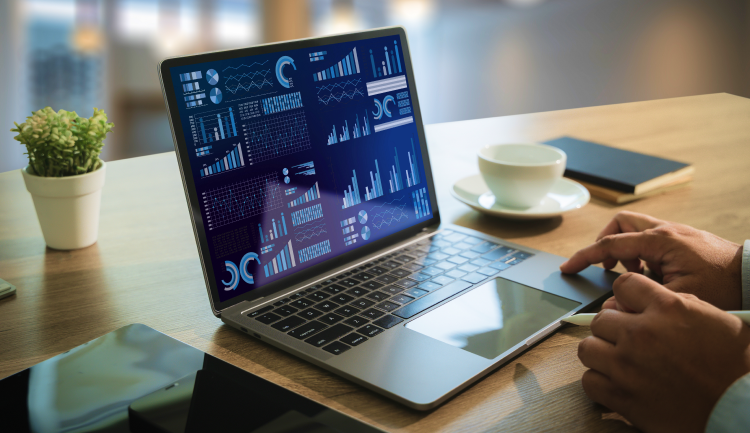
The way we work is changing faster than ever. What once felt advanced – cloud storage, chat platforms, and video meetings—is now the basic foundation of modern work. The next chapter of the digital workplace will not be defined by new tools, but by how those tools connect, communicate, and empower people.
For most companies, “going digital” is no longer a project. It’s a living system that keeps adapting to new technologies, employee needs, and business realities. The challenge now is to prepare for what comes next—without losing focus, control, or human connection.
In this blog post, Hoozin explores the key trends that will shape digital workplaces over the next three to five years and explains how organizations can stay flexible, secure, and ready for change.
Workflows Will Replace Apps
In today’s offices, people jump between dozens of tools – email, messaging, project trackers, HR portals, and CRMs. Each tool promises productivity but often adds friction instead. The future digital workplace will look very different.
Instead of managing separate apps, employees will work inside connected workflows that link tasks, communication, and data in one continuous process. For example, an employee request can start in chat, trigger an automatic approval flow, and update records across multiple systems—without switching tabs.
Why It Matters
- Less cognitive load: Reducing context switching saves time and mental energy.
- Better visibility: Everyone sees where things stand in real time.
- Higher adoption: Employees are more likely to use tools that make sense and feel natural.
Workflows are becoming the new apps. They bring flexibility and structure together—allowing teams to focus on outcomes, not on navigating software.
AI Will Become a Real Co-Worker
Artificial intelligence has already entered the workplace, but its real impact is only beginning. In the next few years, AI will evolve from being a background helper into an active collaborator.
Imagine having an assistant who summarizes long threads, detects process bottlenecks, drafts updates, or recommends next steps—all based on company data and behavior patterns. AI will no longer just automate tasks; it will help make smarter decisions.
Where AI Will Add Value
- Predictive insights: Anticipating what employees or teams might need next.
- Natural-language interaction: Asking questions or issuing commands without complex menus.
- Process optimization: Spotting inefficiencies and suggesting improvements automatically.
However, the success of AI will depend on trust and transparency. Employees need to understand how AI decisions are made and how data is used. Responsible implementation will be key to acceptance.
The Unified Dashboard
Data without structure is noise. The next phase of the digital workplace will focus on creating unified dashboards – interactive control centers that combine information from multiple tools into a single, clear view.
Instead of separate reporting systems for each department, companies will rely on integrated dashboards showing real-time performance indicators. Managers will monitor team progress, workflow bottlenecks, and customer updates all in one place.
Benefits of Unified Dashboards
- Speed: Fast access to relevant data shortens decision time.
- Clarity: Visual dashboards make complex data easy to understand.
- Accountability: Everyone knows where progress stands at any moment.
The unified dashboard will be to the 2030s what email was to the 2000s—a daily anchor of work. It won’t just display information; it will guide action.
From Access to Experience
Digital accessibility used to mean that everyone could log in and use a system. Now, it means far more: that every employee, regardless of role, device, or location, has a comfortable and meaningful experience.
Personalization will drive the next wave of intranet and workplace design. Dashboards, notifications, and layouts will adapt automatically to each user’s behavior and needs. A project manager might see analytics first; a designer might see creative assets; a field employee might see mobile-friendly shortcuts.
The Shift to Experience
- Inclusive design: Interfaces built with accessibility standards in mind.
- Personalization: Content and tools tailored to roles and preferences.
- Emotional usability: Systems that feel simple, supportive, and enjoyable.
When digital workplaces feel intuitive, employees engage more deeply—and productivity naturally follows.

Seamless Integration Across Systems
Every company uses a mix of systems: HR software, finance tools, CRM, project management, and more. For years, these systems operated in silos. The future will be defined by integration.
Open APIs, automation connectors, and universal identity management are making it possible for tools to share data instantly. For example, a sales record in a CRM can update the finance software automatically. A workflow completion can notify HR or trigger a customer message – without human involvement.
Why Integration Is the Future
- Accuracy: Data updates once, everywhere.
- Efficiency: Processes happen faster and with fewer errors.
- Agility: Businesses can respond quickly to new requirements or systems.
Integration turns scattered tools into a single digital ecosystem. It’s not about replacing what works—it’s about connecting what already exists.
Security Will Be User-Centric
Hybrid and remote work have redrawn the boundaries of security. Data is no longer confined to the office network. Employees work from different locations, on various devices, and across multiple platforms.
The traditional model of protecting the perimeter is no longer enough. Security must now travel with the user. Over the next few years, expect to see wider adoption of zero-trust architectures – systems that continuously verify identity and context before granting access.
Key Developments Ahead
- Biometric authentication: Facial or fingerprint ID replacing passwords.
- Smart device trust scores: Systems assessing risk in real time.
- AI threat detection: Continuous monitoring for unusual patterns.
Security is changing from being a technical barrier to becoming part of the everyday user experience. The goal is confidence without complexity.
The Human-Technology Balance
While automation, AI, and integration drive efficiency, the human element remains central. The most successful digital workplaces will be those that strengthen connection rather than replace it.
Tools can make communication faster, but they can’t create purpose. In the coming years, organizations will invest not just in technology, but in the culture that gives that technology meaning.
What Will Matter Most
- Transparency: Clear communication across all levels.
- Recognition: Celebrating achievements to keep teams motivated.
- Belonging: Digital spaces that encourage dialogue and participation.
Even as systems grow smarter, people will remain the heart of progress. Future-ready workplaces will understand that collaboration is built on trust, not on tools alone.
The Evolution of Employee Analytics
As digital workplaces mature, analytics will move beyond measuring clicks or logins. They will focus on outcomes – how people actually work, collaborate, and contribute.
Modern employee analytics will combine behavioral data, workflow metrics, and sentiment feedback to paint a more complete picture of engagement. The purpose is not surveillance, but insight, helping leaders design better experiences and teams find smarter ways to work.
Smart Use of Analytics
- Ethical transparency: Employees must know what data is tracked and why.
- Actionable insights: Metrics should lead to real improvements, not reports.
- Privacy first: Respect for boundaries builds trust.
Data will become a mirror, not a microscope, reflecting how well digital workplaces serve their people.
Sustainability in the Digital Workplace
Sustainability is no longer just about recycling or office lighting. The digital workplace can play a major role in reducing environmental impact.
Remote work reduces commuting. Paperless workflows cut waste. Smart energy management and cloud-based collaboration reduce the physical footprint of operations. Future digital workplaces will continue to embed sustainability into daily processes.
Green Work Practices
- Remote and hybrid work: Fewer emissions from travel.
- Digital documentation: Reducing printing and storage.
- Energy-efficient infrastructure: Data centers powered by renewables.
Sustainability will also shape how technology vendors design and host solutions. The companies that combine productivity with responsibility will gain both efficiency and reputation.

The Continuous Learning Mindset
Technology changes faster than skills can keep up. Future-proof organizations will treat learning as a built-in process, not an occasional event.
Digital workplaces will integrate micro-learning, AI-driven skill recommendations, and peer-to-peer sharing directly into daily workflows. Instead of sending people to external training, learning will happen in the flow of work.
How Continuous Learning Will Evolve
- Personalized development: Learning paths based on roles and goals.
- Integrated systems: Learning tools embedded in everyday apps.
- Culture of curiosity: Rewarding experimentation and improvement.
By turning learning into a habit, companies can stay agile no matter how technology evolves.
Flexibility as the New Stability
The digital workplace of the next few years will be built on flexibility, where infrastructure, policies, and processes can change quickly when needed.
Businesses learned during global disruptions that rigid systems slow response times. Future-ready organizations will design adaptable workflows that can scale up, down, or sideways with minimal effort.
Flexible Strategies Include
- Cloud-based systems: Accessible anywhere, instantly scalable.
- Modular architecture: Adding or removing components without disruption.
- Policy adaptability: Fast updates to match regulatory or market changes.
The goal is not just to survive change, but to move confidently through it.
The Rise of Digital Communities
Intranets and workplace platforms are transforming into digital communities where employees connect through interest groups, projects, and shared knowledge.
These spaces go beyond communication—they foster a sense of belonging and identity. Discussion boards, recognition walls, and informal groups help employees connect with peers outside their immediate teams.
Why Communities Matter
- Stronger engagement: People feel part of something larger.
- Knowledge retention: Information is shared and saved in context.
- Innovation boost: Cross-team discussions spark new ideas.
Over the next few years, digital communities will be the social glue that holds remote and hybrid organizations together.
The Future Manager: Tech-Empowered Leadership
Leaders in the coming years will need more than people skills—they’ll need digital literacy. Managing distributed teams, interpreting analytics, and supporting well-being through technology will become core leadership tasks.
Leadership Trends to Watch
- Data-informed decisions: Using dashboards to track progress and morale.
- Emotional intelligence: Balancing automation with empathy.
- Transparency and visibility: Leading through clarity, not control.
Technology won’t replace leadership—it will redefine it. The best leaders will be those who use digital tools to create openness, trust, and shared accountability.
Preparing Today for Tomorrow
Future-proofing doesn’t mean predicting every trend—it means being ready for all of them. The key is building adaptability into every layer of your organization.
Start by asking:
- Are our systems connected or fragmented?
- Can our workflows evolve without major re-engineering?
- Do employees have the tools and training to adapt quickly?
Answering these questions honestly will help organizations focus their energy where it matters most: flexibility, clarity, and human-centered innovation.
Conclusion
The next three to five years will redefine what the term digital workplace means. It will no longer be a collection of software tools but an intelligent, connected environment that adapts as fast as the people inside it.
Technology will continue to evolve – AI, integration, and automation will lead the way, but the real measure of success will remain human: how well employees feel supported, connected, and empowered to do meaningful work.
Future-proofing isn’t about keeping up with trends. It’s about creating a workplace capable of evolving with them—where progress feels natural, and innovation never stops.
At Hoozin, we stand for a digital workplace that feels human — where technology supports collaboration instead of replacing it, and where every tool serves one clear goal: helping people work better together.
About Hoozin
It is our mission to place actual adoption of ‘next-generation digital work’ before anything else. We know like no other, that Digital Transformation goes through people and their purpose. Organizations using Hoozin are able to reach their digital transformation goals while setting the productivity goals higher. Hoozin serves Fortune 500 firms and governments on all continents. Our unique ability to combine Consulting and scoping with our propriety Digital Platform allows us to solve the most complex Digital Transformation problems.





Leave a reply